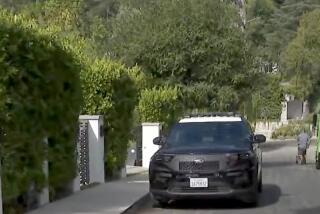Police Task Force Takes 40% Bite Out of Crime
NORTH HILLS â The idea is simple: Flood one square mile with uniformed cops day and night, seven days a week, and watch crime drop.
In a neighborhood where emergency calls are frequent and crime rates high, the Los Angeles Police Department has done just that, and after a month crime has fallen 40%.
The area bounded by Nordhoff Street, Roscoe Boulevard, the San Diego Freeway and Sepulveda Boulevard is being saturated with cops.
âYou put enough uniformed officers on the streets, crime will go somewhere else,â said Lt. Bob Normandie, who oversees detectives at the LAPDâs Devonshire Division.
In the month before the task force, police reported 75 cases of assaults, burglaries, car thefts and robberies in the area known as the Sepulveda corridor. Over the following month, from Oct. 20 to Nov. 18, there were 44 such crimes with the task force at work.
The approach is one of the most basic forms of policing but one that takes money. And because the so-called Sepulveda corridor is divided between the LAPDâs Van Nuys and Devonshire divisions, it also requires cooperation.
âRather than being rivals, which can happen between divisions, weâre cooperatively working together, sharing resources to solve mutual problems,â said Capt. Vance Proctor, who oversees the Devonshire station. âItâs unusual in that Van Nuys and Devonshire are trying to solve problems on our border.â
Said Capt. Richard Wemmer, who oversees the Van Nuys station: âThese officers donât respect any boundary lines . . . and are sharing their expertise.â
The core group is composed of 24 officers and three sergeants, some borrowed from special enforcement details in other parts of the San Fernando Valley.
Deputy Chief Martin Pomeroy, who commands the LAPDâs Valley stations, created the six-month task force in part as a response to neighborhood complaints about drug peddling, as well as burglaries and assaults.
âWithout question, it is the drug dealing that is paramount up there,â said Dan Hoffman, a spokesman for the LAPDâs Valley Bureau. âThereâs a real lack of respect for a neighborhood, for a community. Fear levels have increased.â
The presence of uniformed officers seems to be making a difference.
âIt got bad over 10 years,â said Tony Swan, vice president of the North Hills Community Coordinating Council. âWe wonât correct it in one month but weâre moving in the right direction.â
To be sure, task force sweeps in other areas of the city have earned mixed reviews. Critics say police simply sweep the problem from one neighborhood to another.
In a Northridge neighborhood known as Park Parthenia, police tried a similar approach nearly two years ago. Illegal drug dealing was commonplace and community members were scared and angry. Police launched an attack on that area, barricading certain streets and using extra squads of uniformed officers in patrol cars.
Crime rates dropped, but some believe drug dealers, their customers and other lawbreakers have simply moved on--perhaps to North Hills.
A similar effort has received better reviews. Police saturated a stretch of Blythe Street in Van Nuys, also home to gang trouble and drug dealing. They kept patrol cars stationed on particularly tough blocks and set up barricades. Officers regularly patrolled the neighborhood, and as a result made scores of arrests.
Authorities declared victory over local lawbreakers, then removed the street barricades and moved out.
The current task force effort in North Hills is aimed at stopping the neighborhood problems where they are festering. Authorities say it is also part of a continuing effort to be more cooperative than in past years.
âWhen Devonshire works hard, they push the problem to Van Nuys,â said Swan, the neighborhood activist. âWhen Van Nuys had a problem, it got pushed to Devonshire. The most important thing now is that weâre finally trying not to just push it from one street to the next street.â
In fact, officers are already working more closely together.
Station captains say officers from the two divisions are sharing information. An arrest of one gang member dealing drugs on one block, for instance, allowed officers to link him with other dealers who live across the line dividing the two divisions, police said.
This shared intelligence, along with the high number of officers in the area, leave authorities with high hopes for the five months remaining in the special program.
Said the Devonshire stationâs Proctor: âThereâs no short-term fix for the community in that area. . . . The first step is to get control of the area and eliminate the fear of crime.
More to Read
Sign up for Essential California
The most important California stories and recommendations in your inbox every morning.
You may occasionally receive promotional content from the Los Angeles Times.










